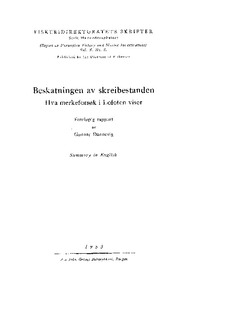| dc.description.abstract | Since 1947 annual tagging experiments have been carried out on
the cod occurring on the Lofoten Banks during the spawning season.
We want inter alia to examine the extent to which the fishermen exploit
this stock of fish.
The results of previous and of present investigations show that the
cod after spawning migrates northwards along the Norwegian coast to
the feeding grounds in the Barents Sea. In November and December
the shoals again approach the Norwegian coast, where they form the
basis of important fisheries during winter and spring.
Comparative experiments have shown the hydrostatic tags to be more
frequently returned in the long run than several types of buttons and
strap tags. The hydrostatic tags have been used in all years; the estimates
of how much the fishery takes of the stock, are based on the results
obtained by this type of tag.
The experiments have been carried out during the main fishing
season in Lofoten. The tagged fish will not at once be distributed in a
representative manner within the total population occurring on these
grounds. The number recaptured on the Lofoten Banks during the season
of tagging depends much on when and where the fish is liberated. The
material also indicates that the tagging process influences the behaviour
of the fish shortly after tagging.
The material has, therefore, been dealt with in the following way.
The fish recaptured on the Lofoten grounds during the season of tagging
is left out of consideration. The number unaccounted for at the end of
that season is taken as a basis when calculating the percentage of recovery
during the following period. In this way the results from the
experiments in a single season should give adequate information as to
how much the fishery takes of the stock leaving the Lofoten grounds
in that year.
The total number of tags returned from the fish leaving the Lofoten
banks in the years 1947-51, varies between 13 and 40 %. These results
indicate that considerable inroads are made by the fishermen on the
stock which has once visited these grounds.
Several nations fish upon this stock of cod, e.g. Germany, Great
Britain, Norway, and Russia. Most of the tags have heen returned by
Norwegian fishermen, especially by those fishing within the Lofoten
district. We do not feel sure, however, that all foreign fishermen have
returned the tags to the same extent as have our own. | en |
